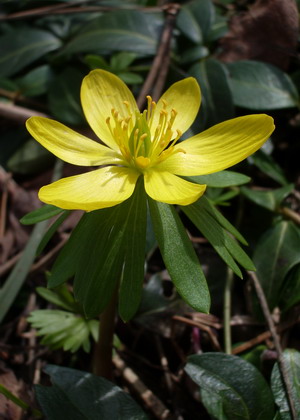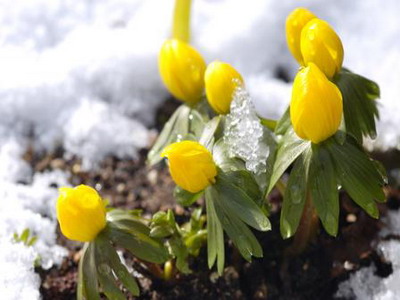
Plant type: bulbous, perennial.
- Origin: Eurasia.
- Flowering: the shape of the flowers is cup-shaped, the shade is yellow.
- Aroma: present.
- Foliage: dark green, shield-shaped, serrated.
- Care: careful.
- Growing environment: garden, greenhouse.
- Temperature range: 4-16°C.
- Humidity level: high.
- Lighting: full sun or partial shade. It is best if the sun’s rays come from the south or west.
Description: in total there are about eight species of these flowers, whose homeland is Europe and Asia. They belong to the buttercup family. The shade of their flowers in most cases is yellow and white. Erantis is one of the first to bloom every year, and its flowers appear in late winter, at a time when the snow has not even completely melted. Its leaves fully bloom after flowering, and they die off after 2-3 months, when the trees are covered with foliage, and the soil is already getting wet. One flower appears on each stalk, which will subsequently be surrounded by straight dark green leaves. In height, these plants reach from 7 to 20 cm, grow in width from 15 to 30 cm. All parts of the plant are poisonous.
Soil type: Almost any soil will be suitable, as long as it has good drainage. Loams are best. The soil can be neutral, it is desirable that it contains a large amount of nutrients.
Watering: During their active growth period, erantis require constant moisture, and during their dormant period, they tolerate dry conditions.
Fertilizers: Feeding is not required, the main thing is that the soil is rich in nutrients.
Propagation: carried out by planting seeds or removing tubers after flowering, but this must be done until the leaves are completely dead. Erantis do not need to be disturbed during hibernation, so harvest tubers prudently. When harvesting tubers, divide them into small sections and transplant immediately. If you reproduce flowers by planting seeds, then the first shoots will appear within a month or a year.

Photo description: erantis from seeds before planting in the ground.
Planting: Erantis tubers should be planted at a distance of 10 cm, and the planting depth should be between 5 and 7 cm. The best time for planting is late summer or early autumn. Soak the tubers overnight before planting.
Pests and Diseases: Usually there are no problems with this flower, because it is poisonous, even rodents avoid it. Most importantly, make sure that the conditions for keeping the tubers are not too wet, otherwise they may rot.
Application: in their natural habitat, all species of these plants grow in the forest, where they thrive in the early spring sun, while the trees are not yet covered with leaves. They look great in the garden under the trees, they are also often grown in rock gardens. Since erantis grow close to the ground, they create a gorgeous garden appearance when they bloom, creating a kind of yellow “carpet”.

Cultivation companions: It should be noted that erantis begin to grow and bloom at the same time as snowdrops. To add contrast, you can also plant lungworts, which also prefer shady conditions.
Eranthis winter – Eranthis hyemalis
This species reaches a height of 7 to 12 cm. It grows well in full sunlight or partial shade. Erantis winter differs from other varieties in that its leaves are slightly larger, and the hue of the flowers is not bright yellow, but rather lemon. And this species blooms one of the first.

Cilician erantis – eranthis cilicica
In addition, Cilician erantis – Eranthis cilicica, whose birthplace is Turkey, is also widespread. This cultivar prefers a shady location and its flowers are bright yellow and slightly larger than other species. The color of the leaves of this variety is also unusual – bronze-green.








